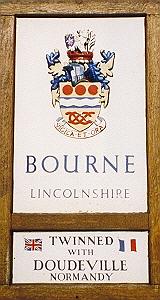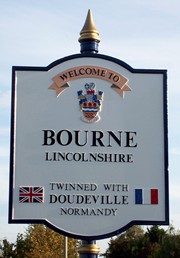|
Town and tourist signs
Signs on the outskirts announcing a town's identity are not a new idea but in recent years they have become more attractive, often with pictorial adornment, a far more welcoming appearance than plain lettering. The first of the new style signs were erected in 1990 at strategic points on the grass verges of the four roads leading into the town centre, South Road, North Road, West Road and Spalding Road. They contained the Bourne coat of arms and a reference to Doudeville, our twin town in Normandy, France, the agreement for which had only been signed the previous year. The signs were made from printed metal sheets framed in oak but soon began to deteriorate. By 2006, the weather had taken its toll and all were showing signs of wear while dust and mud from passing traffic dulled their appearance despite frequent cleaning. The Town Centre Management Partnership (TCMP), formed in February 2001 and now responsible for revitalising Bourne wherever possible, decided that new signs were needed and after consultation with the town council commissioned four new ones made of cast iron with a slightly different design although keeping to the basic idea, and mounted on posts painted black with gilt adornment. Councillor Mrs Jane Kingman Pauley, the
deputy mayor, welcomed them. “Our signs at the moment look scruffy and
some are peeling”, she said. “I think the new ones were badly needed.” He said that the object of replacing them was to maintain the traditional signage of the town by bringing them up to date and making the entrances to Bourne look smarter and this result was admirably achieved.
In February 2005, new tourist signs went up on the
approaches to Bourne telling visitors that it is an historic market town
with a church, a water mill, the place to get a cup of tea and spend a
penny. All of this was true but as with most roadside signs that use the
standard government logos they do not tell the full story.
New town welcome signs were erected in the summer of 2015 on all entrance roads into Bourne although the amenities offered on the previous one have been reduced to just three, the Red Hall which is rarely open to the public, swimming at the outdoor pool which is only open in the summer months, and places to eat in a town where the number of takeaways has increased. Two of our main attractions, the Abbey Church and Baldock’s Mill, have both been excluded for some inexplicable reason together with public toilets, no doubt because they have all been closed except for a small cubicle at the new Community Access Point. REVISED AUGUST 2015 See also Twinning with Doudeville Public lavatories
Go to: Main Index Villages Index
|
||||


